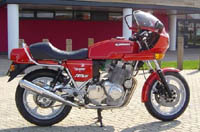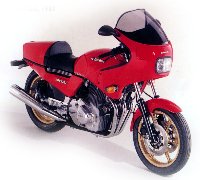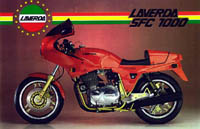TRIPLE - 120 DEGREE
In 1975 the factory produced three works endurance racers with a much-improved frame which became known as 'the spaceframe', thanks to its triangulated nature. In some of these bikes experimental engines were tried with the 120 degree crank throw. The 120 degree format produces a different type of vibration - a rocking couple - and when used in the solidly mounted spaceframe caused vibrational problems but the increased high-rpm performance meant the concept was tagged for future development.
 By the end of the 70's the smooth and powerful Japanese litre-bikes were arriving and Laverda felt they needed to raise performance and also reduce vibration. The 120 engine first saw production in 1982 with the 120 Jota, and the problem of harsh low-rpm vibration of the 120 engine was addressed by rubber engine mounting. It represented quite a change of direction for Laverdas but at this point remained externally very similar to the 81 bike. The gearshift system had
now moved properly to the left with a new (and much improved) selector
mechanism behind the clutch. The 120 Jota also featured a unique gearbox, with a stronger 4-dog arrangement which would carry on in the RGS, but also a close ratio set of gears which only appeared on this model.
By the end of the 70's the smooth and powerful Japanese litre-bikes were arriving and Laverda felt they needed to raise performance and also reduce vibration. The 120 engine first saw production in 1982 with the 120 Jota, and the problem of harsh low-rpm vibration of the 120 engine was addressed by rubber engine mounting. It represented quite a change of direction for Laverdas but at this point remained externally very similar to the 81 bike. The gearshift system had
now moved properly to the left with a new (and much improved) selector
mechanism behind the clutch. The 120 Jota also featured a unique gearbox, with a stronger 4-dog arrangement which would carry on in the RGS, but also a close ratio set of gears which only appeared on this model.
The fairing and tank remained the same, although different sidecovers and ducktail were fitted and the bike generally came in red with gold pinstripes (some euro models had a blue/silver or red/black smoked effect not unlike the contemporary BMWs). Although visually almost identical to the Mk2 180, the engine was of a totally different character. Gone was the off-beat note, changed to a smooth rasp which increased to a wail as the revs climbed. The 120's appetite for revs was quite different to the 180, the engine very smooth over 4000rpm and would rev hard well into the 8000rpm redline. The 120 Jota, produced in very small numbers, was the last of the line for the "old frame", soon to be replaced by the RGS.
 In late 82 the RGS was shown and became available in 1983, it represented
a new direction for the Laverda name and the with a combination of smooth
flowing bodywork, smoother 120 degree motor, 'softer' cam timing and of
course the dreaded noise restrictions, it veered away from the 'caged
animal' reputation that Laverda bikes had gained and aimed perhaps for
the 'exclusive high speed tourer' market. Aside from the obvious
visual changes the bike featured a new frame with a much lower seat height
and generally lower centre of gravity, Veglia electronic instrumentation
including a fuel gauge, a removable
ducktail for quick change between single and dual seating, almost indestructible
'bayflex' bodywork, and the novel feature of a fuel filler in the nose
of the fairing allowing a gloriously smooth tank shape.
In late 82 the RGS was shown and became available in 1983, it represented
a new direction for the Laverda name and the with a combination of smooth
flowing bodywork, smoother 120 degree motor, 'softer' cam timing and of
course the dreaded noise restrictions, it veered away from the 'caged
animal' reputation that Laverda bikes had gained and aimed perhaps for
the 'exclusive high speed tourer' market. Aside from the obvious
visual changes the bike featured a new frame with a much lower seat height
and generally lower centre of gravity, Veglia electronic instrumentation
including a fuel gauge, a removable
ducktail for quick change between single and dual seating, almost indestructible
'bayflex' bodywork, and the novel feature of a fuel filler in the nose
of the fairing allowing a gloriously smooth tank shape.
There
were several spin-off models;
RGS1000 Corsa- This was the hot-rod version with an increase
of 10hp for a claimed total of 94hp achieved by forged high-comp pistons
and cylinder head modifications. Braking was upgraded to state-of-the-art
floating 280mm Brembo discs and goldline calipers, bodywork finished in
black- YUM!.
RGS1000 Executive- The touring oriented model with fairing extensions
covering the hands, higher handlebars and lovely looking integrated panniers
that were unfortunately of such limited volume that they were virtually
useless- looked nice though! Usually finished in silver.
RGA1000 Jota- As for the RGS but without the lovely fairing.
A normal petrol filler replaced the RGS' 'snorkel' and a generally disliked
bikini fairing covered the Nippondenso instruments.
RGA1000- As for the RGA Jota but with the higher Executive bars
and a dual-only seat.
As usual the UK market was looked after by it's enthusiastic importers with some RGA's being sold with a locally made 'sprint' twin headlight fairing and possibly some engine mods on the Jota version. The initial version of the fairing almost completely covered the lovely engine but a later option followed the tank line and looked quite nice.
By this time the finances of the Laverda factory were in big trouble, development of the new range of engines based on the technology learned in the V6 was on hold and the RGS, which was to have been a transitory stage between the old triples and the envisaged new three cylinder 600 or V4-750 engine, looked like being the last hurrah for the historic marque. But they had one more model left up their sleeve in form of the SFC1000.
 SFC1000 - Perhaps in response to the complaints regarding the 'softness' of the
RGS, the SFC was more of a 'bare bones' bike and it shed a little weight
in the use of lightweight bodywork which was similar in shape to the RGS
but much more 'basic'. The moulded fairing interior was replaced
with a set of Smiths (or later Veglia) instruments sitting inside
a bare shell fairing. The frame was as per the RGS, suspension was by Marzocchi M1R forks and Symbol rear shocks,
wheels were new three spoke units and the front discs grew to 300mm.
The engine was lifted straight from the Corsa, itself an RGS with forged
high compression pistons, different valve sizes and some portwork.
The company was by this stage in extreme financial and managerial turmoil
and after claiming to be making only 200 of the machines, all of which
were snapped up quickly, production continued in slightly erratic fashion
for several years thereafter, the last SFC being produced in 1989.
SFC1000 - Perhaps in response to the complaints regarding the 'softness' of the
RGS, the SFC was more of a 'bare bones' bike and it shed a little weight
in the use of lightweight bodywork which was similar in shape to the RGS
but much more 'basic'. The moulded fairing interior was replaced
with a set of Smiths (or later Veglia) instruments sitting inside
a bare shell fairing. The frame was as per the RGS, suspension was by Marzocchi M1R forks and Symbol rear shocks,
wheels were new three spoke units and the front discs grew to 300mm.
The engine was lifted straight from the Corsa, itself an RGS with forged
high compression pistons, different valve sizes and some portwork.
The company was by this stage in extreme financial and managerial turmoil
and after claiming to be making only 200 of the machines, all of which
were snapped up quickly, production continued in slightly erratic fashion
for several years thereafter, the last SFC being produced in 1989.
It was a rather incongruous end for both Moto Laverda and the engine which had won them so much fame. Laverda had always been a technically adventurous company not content to sit on old designs, but large investments in developments such as the V6, 4x4, 350-V3 all brought no return. As such, it is my belief that the development potential in the old triple was not explored, and it was allowed to slip away and Laverda's identity in the marketplace went along with it.

